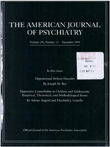Cortical magnetic resonance imaging changes in elderly inpatients with major depression
Abstract
OBJECTIVE: The purpose of the study was to determine if magnetic resonance imaging (MRI) scans of elderly depressed patients differ from MRI scans of age-matched control subjects and age-matched patients with Alzheimer's disease. METHOD: The authors studied 21 patients 60 years or older with major depression, 16 patients with Alzheimer's disease, and 14 age-matched control subjects. RESULTS: Compared to control subjects, depressed patients had greater cerebral sulcal and temporal sulcal atrophy; larger sylvian fissures, lateral ventricles, third ventricles, and temporal horns; and greater severity of subcortical white matter lesions. Depressed patients also had more basal ganglia lesions but similar levels of periventricular hyperintensity. There were no differences between depressed patients with and without delusions on any MRI measure. Depressed patients who received ECT had more temporal horn atrophy and greater subcortical abnormality summary scores than normal subjects. Cortical sulcal atrophy correlated with age at onset of depression. CONCLUSIONS: The findings suggest that elderly hospitalized depressed patients have greater cortical as well as subcortical atrophy and more basal ganglia lesions than age-matched normal control subjects. The correlation of these abnormalities with outcome remains unknown.
Access content
To read the fulltext, please use one of the options below to sign in or purchase access.- Personal login
- Institutional Login
- Sign in via OpenAthens
- Register for access
-
Please login/register if you wish to pair your device and check access availability.
Not a subscriber?
PsychiatryOnline subscription options offer access to the DSM-5 library, books, journals, CME, and patient resources. This all-in-one virtual library provides psychiatrists and mental health professionals with key resources for diagnosis, treatment, research, and professional development.
Need more help? PsychiatryOnline Customer Service may be reached by emailing [email protected] or by calling 800-368-5777 (in the U.S.) or 703-907-7322 (outside the U.S.).



